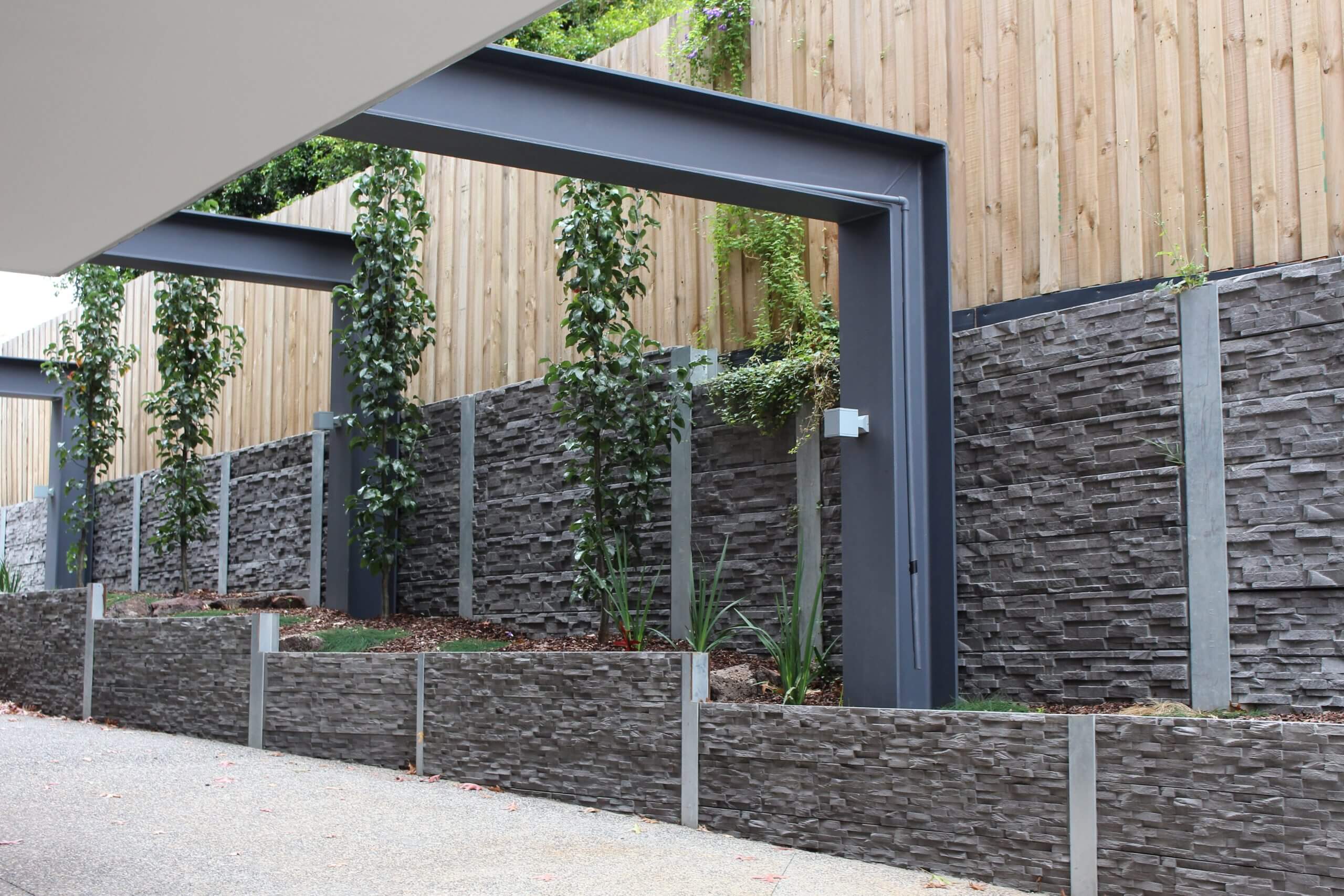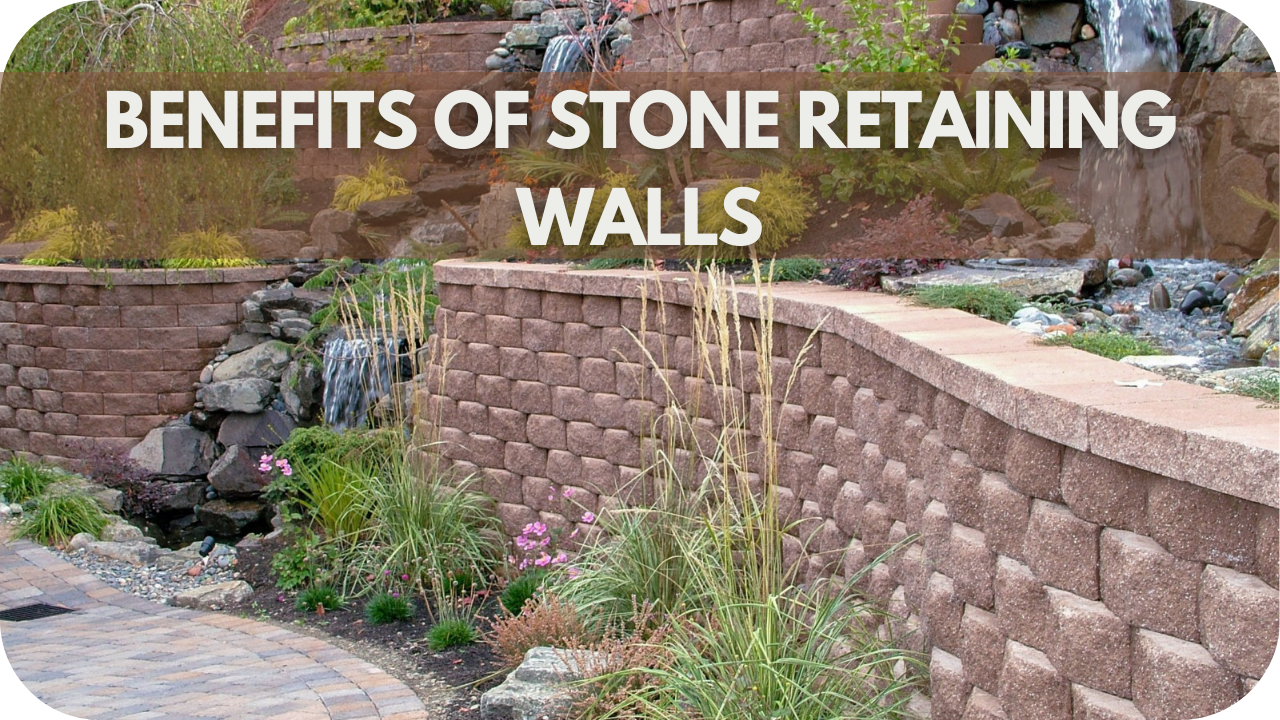The Crucial Guide to Understanding the Capability of Retaining Walls
When it comes to handling sloped landscapes, retaining walls are crucial. What types of retaining walls are available, and exactly how do you select the appropriate products?
What Are Retaining Walls and Their Objective?
Retaining walls are vital frameworks made to keep back soil and prevent erosion, particularly on sloped landscapes. They supply security to your property, guaranteeing that soil stays in position and stopping prospective landslides. When you consider a preserving wall surface, consider its duty in taking care of water drainage, which can deteriorate dirt gradually. Without these walls, you may deal with expensive damage to your landscape and foundation.
Furthermore, retaining walls can create useful spaces in your backyard. By leveling out a sloped location, you can gain a lot more useful outside area for horticulture, patio areas, or play locations. The style and products you choose can improve your residential property's looks, making it visually appealing.
Inevitably, understanding the objective of retaining walls helps you value their importance in landscape monitoring (OKC Precision Retaining Walls). They not only secure your residential or commercial property yet also add to the total appeal and capability of your outside room
Sorts Of Retaining Walls: An Overview
When it pertains to taking care of soil and water overflow in your landscape, recognizing the different types of retaining walls can aid you make an informed option for your property. Gravity walls rely on their weight to keep back dirt, making them a sturdy option for smaller inclines. Cantilever walls, on the various other hand, use a lever-like design, which enables them to sustain extra substantial loads with less product. For even more facility surfaces, secured walls provide extra stability by making use of wires secured into the ground. There are modular block walls, which offer flexibility and simplicity of installment with interlocking blocks. Each kind has its advantages and applications, so take into consideration factors like soil problems, height demands, and visual choices prior to making your decision. Understanding these alternatives will certainly encourage you to enhance your landscape properly while protecting against erosion and managing water overflow.
Trick Materials Used in Retaining Wall Building And Construction
To develop a strong and effective retaining wall surface, picking the ideal materials is necessary. You'll discover that concrete is a popular choice as a result of its toughness and stamina. Precast concrete blocks deal flexibility in layout, while poured concrete provides a smooth appearance. If you prefer an even more natural appearance, rock or brick can include aesthetic appeal and mix with the landscape.
Wood is an additional option, specifically for smaller walls, yet bear in mind it might not last as long due to degeneration. Steel and gabion walls, which use cable mesh full of rocks, are likewise reliable for details scenarios. Each product has its own benefits and downsides, so consider your wall's function, area, and budget plan. Inevitably, the right material will certainly enhance the wall's security and long life, ensuring it satisfies your demands while standing the test of time.

Design Considerations for Efficient Retaining Walls
Designing an efficient retaining wall surface entails mindful consideration of several essential aspects, as the wall surface needs to hold up against both vertical and lateral forces. Initially, assess the soil kind and its residential or commercial properties; natural dirts act differently than granular ones. You'll likewise want to figure out the height of the wall, as taller walls call for even more durable style services.
Next, take into consideration water drainage. Appropriate drain avoids water accumulation behind the wall surface, decreasing pressure and possible failure. Incorporate weep openings or drain pipes for reliable water monitoring.
Additionally, think of the products you'll make use of. Different products, like concrete, rock, or wood, deal differing strengths and looks.
Lastly, don't ignore neighborhood guidelines and codes. They frequently determine style standards and building practices. By attending to these considerations, you can assure your retaining wall is not just functional however also long lasting and safe.
Applications of Retaining Walls in Landscape Design and Construction
Retaining walls serve an essential duty in both landscaping and building, as they aid handle adjustments in elevation and stop soil disintegration. In landscape design, you can use them to develop stunning terraced gardens, permitting you to maximize your outside room while adding visual passion. They also help specify locations, such as pathways or flower beds, improving your landscape's total layout.
In construction, retaining walls supply security to structures improved sloped land, assuring safety and toughness. They're often used in roads and business properties to manage earth motion and water drainage properly. By preventing soil from shifting, retaining walls safeguard structures and preserve the stability of your structure tasks.
Whether you're aiming to enhance curb appeal or guarantee structural stability, retaining walls provide functional solutions that can significantly profit your landscape and building and construction ventures. Embrace their adaptability to achieve both aesthetic and practical objectives.
Maintenance Tips for Long-Lasting Retaining Walls
To keep your retaining walls in excellent form, routine examinations and timely fixings are necessary. You additionally require to assure appropriate drain services to avoid water build-up, which can deteriorate the structure. Handling greenery around the walls will certainly assist preserve their integrity and expand their life expectancy.

Normal Examinations and Repair Work
While you might think your retaining wall surface can stand solid on its very own, routine inspections and prompt repairs are vital for its durability. Look for any type of shifting in the dirt surrounding the wall, as this can indicate much deeper issues. By being aggressive concerning examinations and repair services, you'll ensure your retaining wall continues to be tough and useful for years to come.
Appropriate Drainage Solutions
Reliable drain is vital for preserving the integrity of your retaining wall surface, as visit the website water build-up can lead to significant architectural problems. To ensure appropriate drain, set up weep holes at normal intervals along the wall surface. By carrying out these solutions, you'll improve the longevity and security of your retaining wall, guarding it against possible damage triggered by water accumulation.
Plant Life Administration Strategies
Healthy plant life can play a vital function in the longevity of your retaining wall. To assure its effectiveness, you'll intend to manage the plant around it carefully. Begin by picking deep-rooted plants that aid stabilize the soil without creating pressure on the wall - OKC Precision Retaining Walls. Regularly look for intrusive species that might threaten your wall's integrity.
It's essential to stay clear of overwatering, as too much dampness can deteriorate the wall surface's structure. By carrying out these plants monitoring methods, you'll sustain your retaining wall's sturdiness and improve the bordering landscape's charm.
Typical Issues and Solutions for Retaining Walls
When it comes to retaining walls, soil erosion and water drainage problems can trigger significant frustrations. You need to assure your wall surface is appropriately created to stop erosion and has an effective drainage system in position. Allow's check out some common issues and their options to keep your retaining wall surface strong and practical.
Soil Disintegration Prevention
Soil disintegration can be a significant challenge for retaining walls, specifically otherwise correctly addressed. When dirt erodes, it can threaten the wall's stability, causing prospective failings. To stop this, you should take into consideration planting plant life along the wall's base. Origins assist hold the dirt together, reducing erosion. In addition, utilizing disintegration control blankets or floor coverings can offer prompt protection while plants develop. You can also use compost to reduce surface area runoff and shield the soil. Routine upkeep, like examining for splits or signs of changing, is important to capture concerns early. By taking these proactive actions, you can substantially enhance the long life and effectiveness of your retaining wall versus dirt erosion.
Drain System Value
A reputable water drainage system is essential for the efficiency and durability of retaining walls. Without appropriate water drainage, water can gather behind the wall surface, creating excessive pressure that could result in Visit This Link structural failure. You may observe protruding or fracturing, which signifies the demand for prompt focus. To avoid these issues, consider setting up weep holes, which enable water to leave, or a perforated drainpipe that redirects water away from the wall. Routinely inspect for blockages in your drainage system, as debris can prevent its efficiency. Keeping appropriate drain not only safeguards your retaining wall yet additionally assures the surrounding landscape remains stable. By remaining aggressive, you can prevent expensive repair work and prolong the life of your retaining wall surface.
Frequently Asked Inquiries
Exactly How Do Retaining Walls Affect Water Drainage Solutions?
Retaining walls can considerably influence water drainage systems by redirecting water circulation. They avoid dirt erosion and manage groundwater degrees, ensuring security. If you're planning building and construction, think about just how they'll communicate with your water drainage style for ideal outcomes.
Can Retaining Walls Be Installed on Slopes?
Yes, you can mount retaining walls on slopes. They aid stabilize the dirt and prevent erosion. Simply guarantee appropriate water drainage and select the appropriate materials to manage the stress from the soil behind the wall surface.
What Is the Life-span of a Common Retaining Wall Surface?
A typical retaining wall lasts around 20 to half a century, depending on materials, upkeep, and ecological conditions. You ought to regularly check it to assure its explanation longevity and deal with any kind of issues immediately to stay clear of costly repair work.
Are Allows Needed for Structure Retaining Walls?
Yes, you typically need licenses for developing retaining walls. Examine your regional building ordinance and guidelines to assure compliance. It's important to protect the ideal approvals prior to beginning your project to avoid potential fines or issues.
How Do Retaining Walls Influence Home Worth?
Retaining walls can favorably affect your building worth by boosting visual appeals, avoiding erosion, and creating usable outdoor space. OKC Precision Retaining Walls. They additionally show excellent land monitoring, making your building extra enticing to prospective purchasers on the market